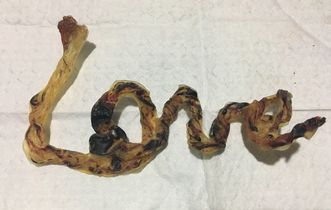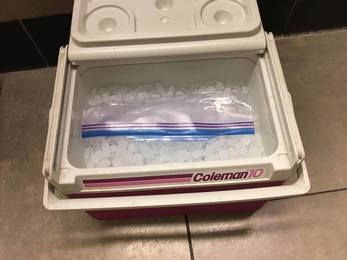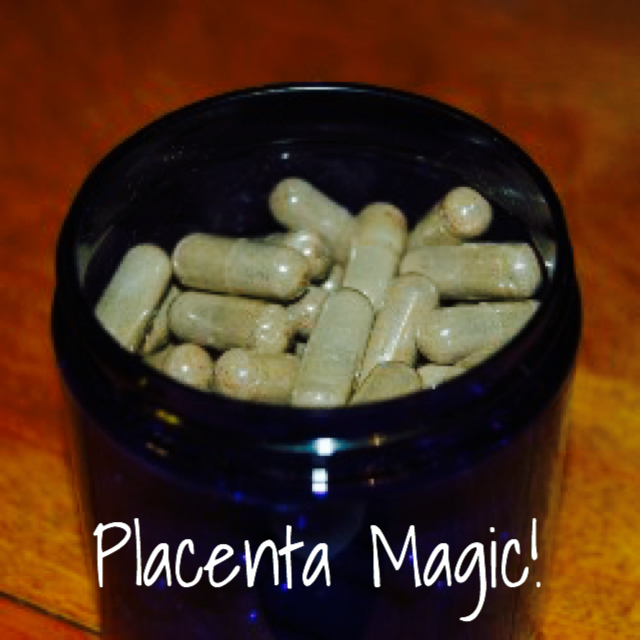MinnesotaPlacenta.com is Powered by Doula Aileen
 A beautiful cord keepsake from a lovely, long umbilical cord.
A beautiful cord keepsake from a lovely, long umbilical cord.
You're Going To Do What With A Human Placenta?
Every kind of mammal - except for one species of camel and the blue whale - consumes their placenta after giving birth. In the last decade an increasing number of people in the Twin Cities and around the country are consuming their placenta in capsule form. The placenta is an amazing organ grown with each pregnancy for the purpose of nourishing a baby during pregnancy. After the birth, placenta capsules can be very nourishing for the birthing person since placental tissue has hormones, iron, and other nutrients to help build back strength after birth.
Many People Report the Following Benefits of Consuming Placenta:
• Reduction in feelings of postpartum sadness and anxiety
• Higher energy levels
• Balanced hormone levels
• Replenished iron levels
• Increased milk production
• Faster return of uterus to pre-pregnant state
• Less postpartum bleeding
We offer two different preparation methods - Traditional Method (steamed) and Raw-Start (heated in the dehydrator but not cooked first). We also offer 1/2 and 1/2 preparation for people wanting the benefits of both methods.
The Traditional Method is based on Traditional Chinese Medicine practices. In this method, the placenta is steamed with lemon, ginger and hot pepper before being sliced and dehydrated for 12-24 hours at 160 degrees. The dehydrated placenta pieces are ground into a fine powder and put into capsules. The lemon, ginger, and hot pepper are used to warm the placenta but they are not dehydrated or added to the capsules. If someone has an allergy or aversion to any of these items, they can easily be left out of the preparation.
More about the Traditional Method (TM):
With the Raw-Start Method, the placenta is not steamed, but is sliced raw and dehydrated. The rest of the process is the same, and clients receive a jar of capsules at the end of the process. We dehydrate the raw-start placenta pieces at 160 degrees for 24 hours to ensure food safety and prevent risks of E. coli, GBS, COVID, food borne pathogens and blood borne pathogens. Thus, it is not a "true" raw food because it is heated above 118 degrees.
More about the raw start method:
A few cautions regarding the raw start method:
Tinctures
We offer add-on placenta tincture starter kit. Tinctures are an excellent way to extend the benefits of placenta consumption for many, many more doses. In our practice it's a small extra charge and clients receive a small piece of placenta in an 8 oz bottle of everclear. This bottle sits on the counter for six weeks (swirling once a day) and then is transferred to the 2 oz. tincture bottle with the funnel and filter we include in the starter kit. The tincture can be used by both the birthing person (think weaning, going back to work, menstrual cycles, stressful times, menopause, etc.) and the child (times of transition, teething, etc.) and should last indefinitely. The recommended dose is 5-10 drops of water in a small amount of water or juice, 1-3 times per day.
Tinctures are an easy way to extend the life of a placenta indefinitely!
Every kind of mammal - except for one species of camel and the blue whale - consumes their placenta after giving birth. In the last decade an increasing number of people in the Twin Cities and around the country are consuming their placenta in capsule form. The placenta is an amazing organ grown with each pregnancy for the purpose of nourishing a baby during pregnancy. After the birth, placenta capsules can be very nourishing for the birthing person since placental tissue has hormones, iron, and other nutrients to help build back strength after birth.
Many People Report the Following Benefits of Consuming Placenta:
• Reduction in feelings of postpartum sadness and anxiety
• Higher energy levels
• Balanced hormone levels
• Replenished iron levels
• Increased milk production
• Faster return of uterus to pre-pregnant state
• Less postpartum bleeding
We offer two different preparation methods - Traditional Method (steamed) and Raw-Start (heated in the dehydrator but not cooked first). We also offer 1/2 and 1/2 preparation for people wanting the benefits of both methods.
The Traditional Method is based on Traditional Chinese Medicine practices. In this method, the placenta is steamed with lemon, ginger and hot pepper before being sliced and dehydrated for 12-24 hours at 160 degrees. The dehydrated placenta pieces are ground into a fine powder and put into capsules. The lemon, ginger, and hot pepper are used to warm the placenta but they are not dehydrated or added to the capsules. If someone has an allergy or aversion to any of these items, they can easily be left out of the preparation.
More about the Traditional Method (TM):
- Human placenta has been used in Traditional Chinese Medicine for centuries. According to TCM practitioners, placenta has been used historically for insufficient lactation, to boost qi/energy (which can be depleted after birth) and to nourish the blood. Steaming is a key part of these properties as TCM also believes that cooling things (like raw placenta) should be avoided in the postpartum period. The cooking process is believed to release beneficial properties in the placenta and make nutrients more easily absorbed by the digestive tract.
- Steaming per our preparation protocol should destroy any viruses or pathogens that may have been picked up on the placenta’s journey outside the body, making it safer for the mother to consume. This included Group Beta Strep (GBS) which is destroyed by steaming.
- Great for people who tend toward anxiety since the TM capsules are warming and healing.
- May increase the amount of iron (ferritin) in the placenta.
With the Raw-Start Method, the placenta is not steamed, but is sliced raw and dehydrated. The rest of the process is the same, and clients receive a jar of capsules at the end of the process. We dehydrate the raw-start placenta pieces at 160 degrees for 24 hours to ensure food safety and prevent risks of E. coli, GBS, COVID, food borne pathogens and blood borne pathogens. Thus, it is not a "true" raw food because it is heated above 118 degrees.
More about the raw start method:
- More of a stimulant. Clients report higher energy levels than with the steamed capsules.
- Yields about 10% more capsules.
- Great for people who tend toward depression since the Raw-Start capsules are energizing.
- Gives a boost to milk supply.
A few cautions regarding the raw start method:
- Many people will benefit from being in bed, resting with their newborn for the first 10-14 days postpartum, breastfeeding, bonding and healing from the birth. Raw capsules can give so much energy that some people may not take enough time to rest and heal.
- Some people experience an oversupply of milk, which can complicate their breastfeeding journey, however there are easy techniques to manage milk supply should it occur.
- Although we dehydrate raw at 160 degrees, this method may not be as safe from a food preparation standpoint as the traditional method because the placenta is not steamed and bacteria could be left behind.
Tinctures
We offer add-on placenta tincture starter kit. Tinctures are an excellent way to extend the benefits of placenta consumption for many, many more doses. In our practice it's a small extra charge and clients receive a small piece of placenta in an 8 oz bottle of everclear. This bottle sits on the counter for six weeks (swirling once a day) and then is transferred to the 2 oz. tincture bottle with the funnel and filter we include in the starter kit. The tincture can be used by both the birthing person (think weaning, going back to work, menstrual cycles, stressful times, menopause, etc.) and the child (times of transition, teething, etc.) and should last indefinitely. The recommended dose is 5-10 drops of water in a small amount of water or juice, 1-3 times per day.
Tinctures are an easy way to extend the life of a placenta indefinitely!
Doula Anne on WCCO - Placenta Pills Can Help Postpartum Depression:
Watch this video of Anne on the news talking about placenta encapsulation!
Doula Aileen's YouTube Channel:
Click here to visit Doula Aileen's YouTube channel where you will find videos about encapsulation methods, safety and sanitization protocols, tincture starter kits, postpartum herbal bath, and more!
 A well-packed placenta ready for transport.
A well-packed placenta ready for transport.
FAQs
Frequently Asked Questions about Placenta Encapsulation
How do you get my placenta?
After the birth you will call or text your encapsulator and she will arrange to come pick it up within a few hours. All Twin Cities hospitals will release placentas. The best way to store your placenta is double bagged in ziploc baggies and then completely surrounded by ice in a hard-sided cooler. (See picture) Some hospitals and birth centers will allow you to keep it in a fridge in your room (or a special fridge the hospital/birth center has for this purpose) until the encapsulator can come pick it up. Many hospitals have buckets to put the placenta in but they are harder to properly chill in a cooler.
Some hospitals want the placenta removed immediately so you will have to have a doula or friend or family member willing to take it home if your encapsulator isn’t available (like in the middle of the night). Another option in this scenario is to put the placenta in your car if the weather cooperates (it's not too hot). For this to work you need a high quality cooler and tons of ice. You will discuss this with your provider before the birth and it is also helpful to put your plans to keep your placenta in your birth plan. If you are birthing at home or at a birth center, you can ask your midwife to put the placenta in the fridge (double bagged) until the encapsulator can come and pick it up.
It's best to bring baggies and a cooler to ensure there is a way to store the placenta and keep it cold no matter what.
What is the cost of encapsulation?
Click here to hop on over to the Aileen's website and view our current prices.
How do I know this process is safe?
We encourage you to have this discussion with your encapsulator so you understand her process. In our work, we follow all standard universal precautions, including wearing gloves, an apron, eyewear, and a mask, and sanitizing our work area and all equipment with a 10% bleach solution. Anne received an internationally recognized certificate in IOSHA blood borne pathogens standard 29 CFR 1090.1030 training and established our safety protocols. Aileen is also certified in IOSHA blood borne pathogens and in placenta encapsulation methods. We take great care to ensure the safety of our clients, and in fact the cleaning and sanitizing of the equipment is the most time consuming part of the process. Additionally, we ask our clients to sign a contract stating they do not have any known blood-borne illnesses.
Can my placenta be encapsulated if I had an epidural or a cesarean? What about if meconium (the baby’s first poop) is present during the birth? Or if I am Group B strep positive?
The answer to all of those questions is yes! The benefits of consuming the placenta should outweigh any risks of the medication that may be in the placenta but of course that will always be up to the family to make a decision. If meconium is present, if will be washed off, and the steaming process (with the TCM method) should kill any possible bacteria. If meconium is present, the encapsulator may want to briefly soak the placenta in some sort of alcohol like vodka or everclear to provide an extra layer of protection. The alcohol can then be washed off the the rest of the process can take place. If a mom is positive for GBS and wants to be certain all bacteria is killed in the process then we recommend choosing the Traditional Method. Click here to read more about GBS and encapsulation. My certifying organization APPA has also written about GBS and encapsulation here.
How many capsules will I get?
This all depends on the size of your placenta and the method you choose. Placentas tend to match the size of the baby, so if you have a small baby, the placenta is likely to be on the smaller side, and bigger babies tend to have bigger placentas. Following a healthy diet during pregnancy will help your placenta be healthy and just right for you and your baby!
With the traditional method, and depending on capsule size, you may get anything from 100 to 175 capsules. With the raw start method it’s anywhere from 125-250.
How do I store my capsules?
Current best practice is to leave the capsules in a dark, dry place like a cabinet in your kitchen. Leaving them on your nightstand or in your bathroom, out of direct sunlight, would probably help you remember to take them in the early weeks!
What dosage is recommended?
Every person and placenta are different. It is important to listen to your body to determine what your perfect dosage is. Some people may prefer more capsules per day, while others prefer less. Our suggested dosage for the average person is 2 capsules, 3 times a day (breakfast, lunch, and dinner) for the first 2 weeks then slowly weaning down from there. Some TCM practitioners suggest taking the pills with a little sake/wine, saying that it helps diffuse the energy throughout the body. After 2 weeks you can start to decrease the dosage down to 1 or 2 pills a day as needed. Some people save the remainder in the back of the freezer for PMS, stressful days, or even menopause. Mothers may wish to take more if they had a cesarean birth, a hemorrhage, and/or are worried about mood or milk supply. Other mothers who are feeling great may take less from the start.
Can you encapsulate a placenta that has been frozen for a while?
Yes! We have encapsulated placentas that are quite a few months old. If the placenta has been in a deep freezer it will probably be just fine. The encapsulator can defrost it by putting it in a fridge for 24-48 hours and then seeing if it still looks and smells healthy. However, it is preferable to work with a fresh placenta that has not been frozen at all. The placenta can be left in a fridge for up to 4 days before it is processed. If you know your placenta will not be processed within a couple days, it may be better to freeze it right away, though some believe freezing it will destroy some of the beneficial properties.
Frequently Asked Questions about Placenta Encapsulation
How do you get my placenta?
After the birth you will call or text your encapsulator and she will arrange to come pick it up within a few hours. All Twin Cities hospitals will release placentas. The best way to store your placenta is double bagged in ziploc baggies and then completely surrounded by ice in a hard-sided cooler. (See picture) Some hospitals and birth centers will allow you to keep it in a fridge in your room (or a special fridge the hospital/birth center has for this purpose) until the encapsulator can come pick it up. Many hospitals have buckets to put the placenta in but they are harder to properly chill in a cooler.
Some hospitals want the placenta removed immediately so you will have to have a doula or friend or family member willing to take it home if your encapsulator isn’t available (like in the middle of the night). Another option in this scenario is to put the placenta in your car if the weather cooperates (it's not too hot). For this to work you need a high quality cooler and tons of ice. You will discuss this with your provider before the birth and it is also helpful to put your plans to keep your placenta in your birth plan. If you are birthing at home or at a birth center, you can ask your midwife to put the placenta in the fridge (double bagged) until the encapsulator can come and pick it up.
It's best to bring baggies and a cooler to ensure there is a way to store the placenta and keep it cold no matter what.
What is the cost of encapsulation?
Click here to hop on over to the Aileen's website and view our current prices.
How do I know this process is safe?
We encourage you to have this discussion with your encapsulator so you understand her process. In our work, we follow all standard universal precautions, including wearing gloves, an apron, eyewear, and a mask, and sanitizing our work area and all equipment with a 10% bleach solution. Anne received an internationally recognized certificate in IOSHA blood borne pathogens standard 29 CFR 1090.1030 training and established our safety protocols. Aileen is also certified in IOSHA blood borne pathogens and in placenta encapsulation methods. We take great care to ensure the safety of our clients, and in fact the cleaning and sanitizing of the equipment is the most time consuming part of the process. Additionally, we ask our clients to sign a contract stating they do not have any known blood-borne illnesses.
Can my placenta be encapsulated if I had an epidural or a cesarean? What about if meconium (the baby’s first poop) is present during the birth? Or if I am Group B strep positive?
The answer to all of those questions is yes! The benefits of consuming the placenta should outweigh any risks of the medication that may be in the placenta but of course that will always be up to the family to make a decision. If meconium is present, if will be washed off, and the steaming process (with the TCM method) should kill any possible bacteria. If meconium is present, the encapsulator may want to briefly soak the placenta in some sort of alcohol like vodka or everclear to provide an extra layer of protection. The alcohol can then be washed off the the rest of the process can take place. If a mom is positive for GBS and wants to be certain all bacteria is killed in the process then we recommend choosing the Traditional Method. Click here to read more about GBS and encapsulation. My certifying organization APPA has also written about GBS and encapsulation here.
How many capsules will I get?
This all depends on the size of your placenta and the method you choose. Placentas tend to match the size of the baby, so if you have a small baby, the placenta is likely to be on the smaller side, and bigger babies tend to have bigger placentas. Following a healthy diet during pregnancy will help your placenta be healthy and just right for you and your baby!
With the traditional method, and depending on capsule size, you may get anything from 100 to 175 capsules. With the raw start method it’s anywhere from 125-250.
How do I store my capsules?
Current best practice is to leave the capsules in a dark, dry place like a cabinet in your kitchen. Leaving them on your nightstand or in your bathroom, out of direct sunlight, would probably help you remember to take them in the early weeks!
What dosage is recommended?
Every person and placenta are different. It is important to listen to your body to determine what your perfect dosage is. Some people may prefer more capsules per day, while others prefer less. Our suggested dosage for the average person is 2 capsules, 3 times a day (breakfast, lunch, and dinner) for the first 2 weeks then slowly weaning down from there. Some TCM practitioners suggest taking the pills with a little sake/wine, saying that it helps diffuse the energy throughout the body. After 2 weeks you can start to decrease the dosage down to 1 or 2 pills a day as needed. Some people save the remainder in the back of the freezer for PMS, stressful days, or even menopause. Mothers may wish to take more if they had a cesarean birth, a hemorrhage, and/or are worried about mood or milk supply. Other mothers who are feeling great may take less from the start.
Can you encapsulate a placenta that has been frozen for a while?
Yes! We have encapsulated placentas that are quite a few months old. If the placenta has been in a deep freezer it will probably be just fine. The encapsulator can defrost it by putting it in a fridge for 24-48 hours and then seeing if it still looks and smells healthy. However, it is preferable to work with a fresh placenta that has not been frozen at all. The placenta can be left in a fridge for up to 4 days before it is processed. If you know your placenta will not be processed within a couple days, it may be better to freeze it right away, though some believe freezing it will destroy some of the beneficial properties.
What is the evidence for placenta encapsulation?
Scientific evidence is still very limiited but this video from Rebecca Dekker of www.evidencebasedbirth.com has great information on research that has come out in 2016 and 2017.
Scientific evidence is still very limiited but this video from Rebecca Dekker of www.evidencebasedbirth.com has great information on research that has come out in 2016 and 2017.


